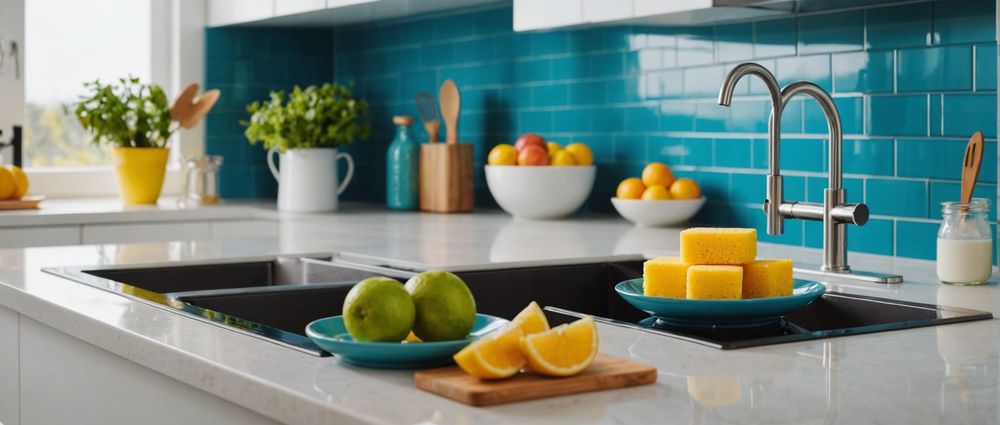Germs lurk everywhere in our daily surroundings, but some items are notorious hotspots for bacteria and viruses. Neglecting these items when cleaning can lead to potential health risks, especially in high-traffic areas of your home or office. This article will delve into five germ-riddled items you should prioritize in your cleaning routine. From your kitchen appliances to your phone, understanding these common sources of germs will encourage more effective cleaning practices.
1. Kitchen Sponges: The Unsung Germ Magnets

Kitchen sponges are a breeding ground for bacteria due to their high moisture content and frequent contact with food particles. Studies have shown that sponges can harbor more bacteria than your toilet seat! Cleaning utensils should be sanitized regularly to prevent the transfer of germs to your dishes and surfaces. To clean your sponge effectively, you can use the following methods:
- Microwave: Place a damp sponge in the microwave for two minutes to kill off bacteria.
- Dishwasher: Run your sponge through the dishwasher during a hot cycle.
- Bleach solution: Soak the sponge in a bleach solution for a few minutes, then rinse thoroughly.
Make it a habit to replace your sponges every month, and don’t forget to wash your hands after using them to avoid cross-contamination!
2. Doorknobs and Light Switches: High-Touch Areas

Doorknobs and light switches are among the most frequently touched objects in any building, making them perfect breeding grounds for germs. They are often overlooked during routine cleaning, leading to a build-up of harmful bacteria. You should clean these surfaces with a disinfectant at least once a week to keep them germ-free. Here’s how to effectively clean these high-touch areas:
- Use an all-purpose cleaner or disinfectant wipes.
- Pay close attention to the grooves around knobs and switches.
- Consider using a UV sterilizer for an added level of sanitation.
Additionally, encourage family members or coworkers to wash their hands before and after using these areas to minimize germ transfer.
3. Your Mobile Phone: Pocket-Sized Germ Factories
Your mobile phone is a device that you often carry everywhere, making it a prime target for germs. Studies found that mobile phones can contain more bacteria than a bathroom faucet! The screen and casing can easily accumulate oils, food particles, and germs from your fingers. Here’s how to keep your phone clean:
- Use microfiber cloths: Gently wipe the screen and casing with a microfiber cloth dampened with alcohol-based cleaner.
- Consider phone cases: Invest in a case that can withstand cleaning regimens without losing quality.
- Regular sanitization: Make it a point to sanitize your phone daily, especially during illness outbreaks.
You’ll not only keep your phone cleaner but also reduce the overall bacteria transferred to your face and hands.
4. Computer Keyboards: Hidden Havens for Germs

Similar to mobile phones, computer keyboards are rarely cleaned but are a hotspot for bacteria and dirt. The gaps between the keys are prime breeding grounds for dust, crumbs, and germs. Research indicates that keyboards can host as many bacteria as a toilet seat. It’s essential to clean your keyboard regularly. Here’s how:
- Unplug the keyboard before cleaning to avoid damage.
- Shake or gentle invert the keyboard to dislodge debris.
- Use compressed air to blow out dirt from between the keys.
- Wipe down with disinfecting wipes, ensuring to get all surfaces.
Incorporating keyboard cleaning into your monthly cleaning routine can help maintain a healthier workspace.
5. Pet Supplies: Your Furry Friends’ Germ Carriers
While pets are adored members of our households, their supplies can harbor plenty of germs. Bowls, toys, and bedding can collect bacteria and odors over time. It is essential to clean these items regularly to ensure a healthy environment for both you and your pets. Consider the following cleaning tips:
-
Food and water bowls:
Wash with hot soapy water at least once a week, or more if they appear soiled. -
Toys:
Wash fabric toys in the washing machine; non-fabric toys can be cleaned with a damp cloth and disinfectant. -
Bedding:
Wash pet bedding in hot water regularly to kill bacteria, and dry thoroughly.
By incorporating these cleaning habits, you’ll ensure a cleaner space and a healthier companion.
Conclusion
Cleaning is an essential habit, but focusing on specific germ hotspots can amplify your efforts to maintain a safe and healthy environment. By regularly attending to kitchen sponges, doorknobs, mobile phones, computer keyboards, and pet supplies, you will significantly reduce the risk of germ transmission in your daily life. Adopt these habits and make germ-free living a priority for you and those around you.
FAQs
1. How often should I clean my kitchen sponge?
It’s recommended to clean your kitchen sponge at least once a week and replace it every month.
2. What disinfectants are best for cleaning high-touch surfaces?
Disinfectant wipes, alcohol-based sprays, and homemade bleach solutions are effective options for cleaning high-touch areas.
3. Can I clean my phone without damaging it?
Yes, you can safely clean your phone using microfiber cloths and alcohol-based cleaners specifically designed for electronics.
4. How often should I clean my pet’s supplies?
Pet food and water bowls should be cleaned weekly, while toys and bedding should be washed every few weeks or as needed.
5. What should I do if I’m sick? Should I change my cleaning routine?
If you’re sick, increase the frequency of cleaning high-touch surfaces and items to prevent spreading germs to others.